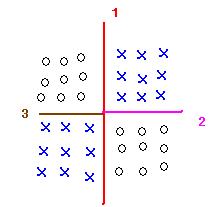| Line 1: | Line 1: | ||
Note: Most tree growing methods favor greatest impurity reduction near the root node. | Note: Most tree growing methods favor greatest impurity reduction near the root node. | ||
| + | |||
Ex. | Ex. | ||
[[Image:Lecture22_DecisionTree_Old Kiwi.JPG]] | [[Image:Lecture22_DecisionTree_Old Kiwi.JPG]] | ||
To assign category to a leaf node. | To assign category to a leaf node. | ||
| + | |||
Easy! | Easy! | ||
| + | |||
If sample data is pure | If sample data is pure | ||
| − | + | ||
| + | -> assign this class to leaf. | ||
| + | |||
else | else | ||
| − | + | ||
| + | -> assign the most frequent class. | ||
Note: Problem of building decision tree is "ill-conditioned" | Note: Problem of building decision tree is "ill-conditioned" | ||
| + | |||
i.e. small variance in the training data can yield large variations in decision rules obtained. | i.e. small variance in the training data can yield large variations in decision rules obtained. | ||
Ex. p.405(D&H) | Ex. p.405(D&H) | ||
| + | |||
A small move of one sample data can change the decision rules a lot. | A small move of one sample data can change the decision rules a lot. | ||
Reference about clustering | Reference about clustering | ||
| + | |||
"Data clustering, a review" A. K. Jain, M. N. | "Data clustering, a review" A. K. Jain, M. N. | ||
Revision as of 10:43, 3 April 2008
Note: Most tree growing methods favor greatest impurity reduction near the root node.
To assign category to a leaf node.
Easy!
If sample data is pure
-> assign this class to leaf.
else
-> assign the most frequent class.
Note: Problem of building decision tree is "ill-conditioned"
i.e. small variance in the training data can yield large variations in decision rules obtained.
Ex. p.405(D&H)
A small move of one sample data can change the decision rules a lot.
Reference about clustering
"Data clustering, a review" A. K. Jain, M. N.


